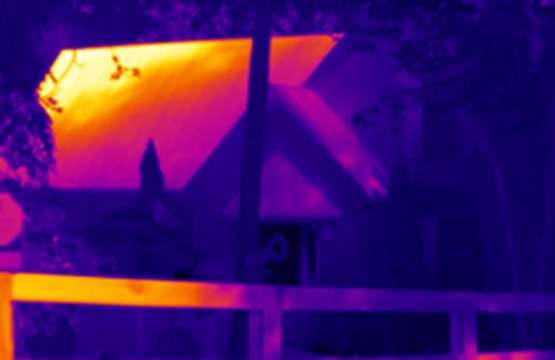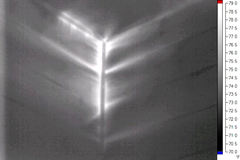

People may consider the application of thermography for building inspections to be something for geographic areas where the temperatures get very low. I live in the Deep South, and when I mention building inspections to the folks around here, they respond with “why would you do that here? It doesn’t get that cold”. While up in New England, where our corporate office is located, heat loss is a great concern, down here in hot and humid Georgia heat gain is an issue. Conduction and air leakage inspections can and in fact should be conducted in warm weather areas and can be performed in warm weather conditions. However, just as in other applications, there are concerns that need to be addressed for optimum success.
Chief among these concerns is reaching a sufficient inside surface to outside surface Delta temperature. The ASTM C1060, Standard Practice for Thermographic Inspections of Insulation Installations in Envelope Cavities of Frame Buildings specifies an 18°F (10°C) differential for frame building inspections, but the fact of the matter is that success can be had with lower Deltas. Imager sensitivity and resolution obviously have an impact on that success, but assuming you’re deploying a higher resolution system, you should be good to go. In warm weather, however, getting to that Delta might be tough. One opportunity is going to be in the morning before direct sun exposure occurs. That’s when the outside temperature is going to be lowest, therefore you might need to employ HVAC to drive the interior temperature down to a level that expands that differential. Alternately a warm overcast day is a good opportunity. The inside to outside Delta is likely to be higher then. In my region, even with conservatively applied interior cooling, midday Deltas can be greater than 20°F at the height of Summer.
Another consideration is the rate of convective cooling that occurs in warmer weather. Newton’s Law of Cooling states that the higher the Delta between a surface and a point in the flow stream of the fluid surrounding it (in buildings that’s air) the greater the rate of transfer. In warm weather, cooling from the effects of solar loading can take longer to occur than in cooler weather. See the image above. The porch rails are painted a darker color than the siding on the rest of the building. Solar exposure to the front of this house had ceased over 3 hours prior to this image, but the air temperature was above 90°F. The porch rails were cooler than when the sun was directly on them but are cooling much more slowly than they would with a milder temperature. So, the three-hour solar exposure rule wasn’t enough time for them to not show solar loading effects.
 One potentially positive effect of solar loading, particular in warm weather inspection conditions, is the impact on air leakage inspections. The ASTM 1186, Standard Practices for Air Leakage Site Detection in Building Envelopes and Air Barrier Systems suggests a minimum 9°F (5°C) inside to outside Delta to detect air leakage. In warm weather conditions, the high exterior air temperature will serve to enhance the patterns associated with air infiltration, making them easier to detect. The downside though is that with a cooler interior temperature the pressure differential will likely require artificial enhancement for the warmer air to be drawn into the interior. Here’s where running a blower door pays off handsomely.
One potentially positive effect of solar loading, particular in warm weather inspection conditions, is the impact on air leakage inspections. The ASTM 1186, Standard Practices for Air Leakage Site Detection in Building Envelopes and Air Barrier Systems suggests a minimum 9°F (5°C) inside to outside Delta to detect air leakage. In warm weather conditions, the high exterior air temperature will serve to enhance the patterns associated with air infiltration, making them easier to detect. The downside though is that with a cooler interior temperature the pressure differential will likely require artificial enhancement for the warmer air to be drawn into the interior. Here’s where running a blower door pays off handsomely.
Don’t make the mistake of thinking that buildings in areas where the weather is warm aren’t candidates for inspection. Think Thermally!® and you’ll do just fine.